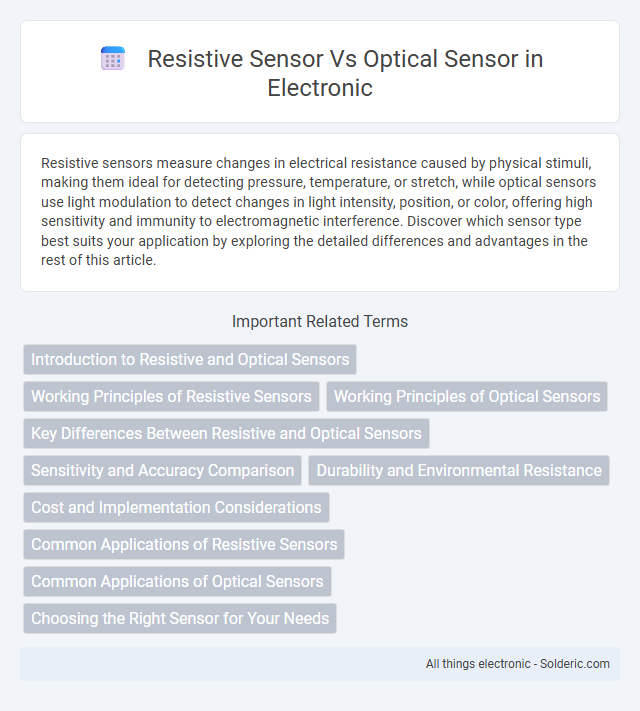Resistive sensors measure changes in electrical resistance caused by physical stimuli, making them ideal for detecting pressure, temperature, or stretch, while optical sensors use light modulation to detect changes in light intensity, position, or color, offering high sensitivity and immunity to electromagnetic interference. Discover which sensor type best suits your application by exploring the detailed differences and advantages in the rest of this article.
Comparison Table
| Feature | Resistive Sensor | Optical Sensor |
|---|---|---|
| Working Principle | Measures change in electrical resistance | Detects light intensity or interruptions |
| Common Applications | Touchscreens, pressure sensing | Distance measurement, object detection |
| Sensitivity | Moderate sensitivity, affected by wear | High sensitivity, precise detection |
| Durability | Prone to contact wear and damage | Non-contact, longer lifespan |
| Cost | Generally low cost | Higher cost due to optical components |
| Environmental Impact | Affected by dust and moisture | Less affected by environmental conditions |
| Response Time | Slower response | Fast response |
Introduction to Resistive and Optical Sensors
Resistive sensors detect changes in electrical resistance caused by physical interactions such as pressure, temperature, or humidity variations. Optical sensors operate by detecting changes in light intensity, wavelength, or phase, commonly used in applications like motion detection, distance measurement, and fiber optic communication. Both sensor types serve critical roles in automation, robotics, and environmental monitoring, with resistive sensors offering cost-effective solutions and optical sensors providing high precision and non-contact measurement capabilities.
Working Principles of Resistive Sensors
Resistive sensors operate by detecting changes in electrical resistance caused by physical stimuli such as pressure, temperature, or humidity. When the sensor experiences deformation or variation in environmental conditions, its conductive material's resistance alters proportionally, enabling precise measurement. This simple yet effective principle allows resistive sensors to convert mechanical or environmental changes directly into electrical signals.
Working Principles of Optical Sensors
Optical sensors operate based on the detection of light changes, utilizing principles such as photodetection, reflection, refraction, or absorption to sense physical parameters. These sensors convert light signals into electrical signals through photodiodes, phototransistors, or photovoltaic cells, enabling precise measurement of distance, color, or intensity. Unlike resistive sensors that detect changes in resistance due to physical deformation, optical sensors rely on light modulation for high accuracy and non-contact measurements.
Key Differences Between Resistive and Optical Sensors
Resistive sensors operate by detecting changes in electrical resistance due to physical stimuli such as pressure, temperature, or strain, making them ideal for applications requiring direct contact measurement. Optical sensors use light properties, including intensity, wavelength, or phase changes, to detect objects or environmental changes, offering high sensitivity and non-contact operation. Key differences include resistive sensors' susceptibility to wear and environmental interference versus optical sensors' immunity to electromagnetic noise and higher precision in detecting fine movements or changes.
Sensitivity and Accuracy Comparison
Resistive sensors typically offer lower sensitivity and accuracy due to their reliance on changes in electrical resistance, which can be affected by environmental factors like temperature and humidity. Optical sensors provide higher sensitivity and accuracy by detecting variations in light intensity, wavelength, or polarization with minimal interference from external conditions. The superior performance of optical sensors makes them ideal for applications requiring precise measurements, such as biomedical diagnostics and industrial quality control.
Durability and Environmental Resistance
Resistive sensors exhibit high durability due to their simple construction, offering excellent resistance to mechanical wear and harsh environmental conditions such as dust, humidity, and temperature fluctuations. Optical sensors, while highly sensitive and precise, can be more vulnerable to environmental factors like dirt, fog, and bright ambient light, which may degrade their performance or require frequent cleaning and calibration. For applications demanding robust environmental resistance and long-term durability, resistive sensors are often favored over optical counterparts.
Cost and Implementation Considerations
Resistive sensors typically offer lower cost and simpler implementation due to their basic construction and straightforward signal processing requirements. Optical sensors generally involve higher expenses because of complex components like light sources and detectors, as well as more intricate calibration and alignment needs. Your choice depends on balancing budget constraints with the desired sensing accuracy and environmental robustness.
Common Applications of Resistive Sensors
Resistive sensors are widely used in applications such as touch screens, pressure measurement, and temperature sensing due to their simplicity and cost-effectiveness. These sensors reliably detect changes in resistance caused by physical interactions, making them ideal for wearable devices, industrial controls, and automotive systems. Your projects involving real-time monitoring or tactile input can benefit significantly from the robust and straightforward design of resistive sensors.
Common Applications of Optical Sensors
Optical sensors are widely used in applications such as industrial automation, healthcare, and environmental monitoring due to their high precision and non-contact measurement capabilities. They excel in detecting light intensity, color, and distance, making them ideal for barcode scanners, medical pulse oximeters, and air quality monitoring systems. Your choice of sensor should consider these applications to leverage optical sensors' advantages over resistive sensors in accuracy and durability.
Choosing the Right Sensor for Your Needs
Resistive sensors operate by measuring changes in electrical resistance due to physical stimuli, making them ideal for applications requiring simplicity, low cost, and durability in harsh environments. Optical sensors detect variations in light intensity or wavelength, offering high precision and faster response times suitable for complex, high-speed detection tasks. Understanding your specific requirements for accuracy, environmental conditions, and budget will guide you in choosing the right sensor technology tailored to your needs.
Resistive sensor vs optical sensor Infographic

 solderic.com
solderic.com